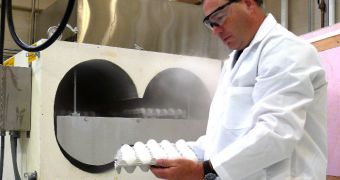One of the methods the poultry industry could use to reduce future risks of salmonella outbreaks could be to apply a new step in the technological process, that would cool the fresh eggs right after they are produced.
According to investigators at the Purdue University, this would ensure that the risk of outbreaks such as the one that took place recently in the United States is significantly diminished.
The leader of the study, Purdue associate professor of food science Kevin Keener, says that cooling the eggs immediately after they are laid by chicken could hamper the development of salmonella within.
The pathogen can make its way into the eggs via the shell, using a number of methods. The most common include feces contamination, and transmission from infected chickens.
In either case, the infection can be prevented if the egg is cooled. Salmonella cannot divide and multiply properly in low temperature, and so this could represent a low-cost, high-efficiency public health measure, experts believe.
At this point, there are no federal guidelines in the United States, forcing producers to cool eggs. The industry does it anyway, but it can sometimes take up to six days for a egg to be brought to 45 degrees Fahrenheit.
This gives salmonella ample time to multiply and develop, thus increasing the risk of outbreaks when the products are consumed. What Keener created is a technology that freezes the eggs in 2 to 5 minutes.
The eggs are very hot after they have been packaged, reaching temperatures as high as 100 degrees F.
About 36 of them are placed in a case, after which 30 cases are stacked in a pallet. Many pallets are then placed in a refrigerator, but it can take up to 142 hours (almost 6 days) for the eggs in the middle of the stacks to cool.
“The eggs in the middle of a pallet may take up to six days to cool, and if the one in 20,000 that has salmonella is in the middle, the bacteria will grow. In reality, some eggs don't cool to 45 degrees until they're in the refrigerator in your home,” the expert says.
“Our industry is good at adopting practical solutions. If there is a technology that we could adopt to address an issue and it was cost-effective, I'm sure we would embrace it,” says Paul Brennan.
He is the executive vice president of the Indiana State Poultry Association, which is based at Purdue. Keener's study shows that cooling eggs to 45 degrees Fahrenheit within 12 hours of being laid could reduce salmonella infections in the US by up to 78 percent.
“Continue to buy eggs, cook them properly and you will not have a problem from a health standpoint. Food is not sterile, but industry does everything it can to eliminate the possibility of illnesses,” Brennan concludes.

 14 DAY TRIAL //
14 DAY TRIAL //